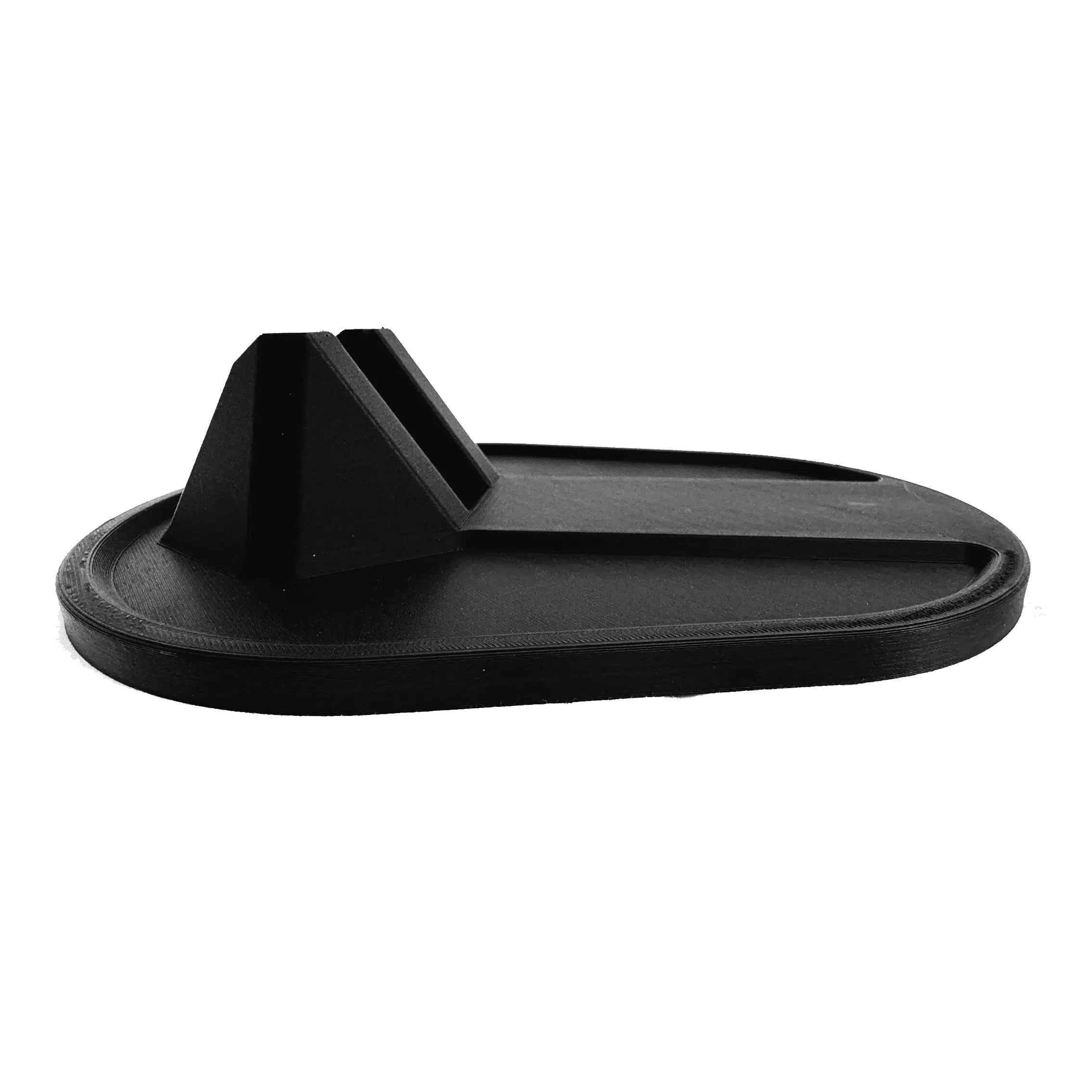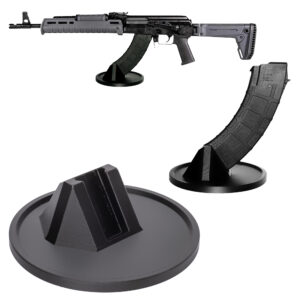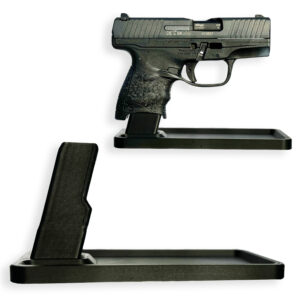
Categories:
The AK-47, one of the most iconic and widely used assault rifles in the world, is renowned for its durability, reliability, and simple design. A key component of this venerable gun is its recoil system, which plays a crucial role in the weapon’s functionality and smooth operation. At the heart of the AK-47’s recoil system is the recoil spring, a fundamental part that absorbs shock and ensures the bolt carrier group returns to its original position after each shot is fired.
When a round is discharged, the powerful force generated by the expanding gases propels the projectile forward through the barrel. Simultaneously, this energy drives the bolt carrier group backward, necessitating an effective mechanism to manage the recoil and return the system to a ready state for the next shot. Herein lies the importance of the recoil spring. As the bolt carrier group travels rearward under the influence of the combustion gases, the recoil spring is compressed.
This compression acts as a buffer, absorbing the energy that would otherwise be transferred violently through the gun and into the shooter’s shoulder.
The energy stored within the compressed recoil spring is then used to return the bolt carrier group forward, chambering the next round from the magazine and preparing the gun for subsequent firing. This process must occur seamlessly to maintain the AK-47’s famed reliability under various conditions, including extreme heat, cold, and dirt. The recoil spring ensures that the cyclic rate of the weapon is maintained at an optimal level, preventing malfunctions and ensuring a consistent rate of fire.
Moreover, the simplicity of the AK-47’s design shines through in its recoil system. The recoil spring, along with its guide rod, can be easily accessed and maintained, which further contributes to the weapon’s reputation for being robust and user-friendly. Its straightforward design, devoid of overly complex mechanisms, means that any necessary repairs or replacements can be performed with minimal tools, making the AK-47 a preferred choice for many military forces, guerrilla groups, and private users alike.
In essence, the recoil system of the AK-47 exemplifies a perfect balance of function and durability, embodying the rifle’s enduring legacy as a dependable and effective gun.
The recoil spring in the AK-47 is an essential component that plays a critical role in the operation of this legendary rifle. When a round is fired, the explosion generates significant force, propelling the bullet forward and, at the same time, creating backward momentum. This is where the recoil spring comes into action. Connected to the bolt carrier group, the recoil spring absorbs much of the shock generated during the firing sequence and utilizes this energy to cycle the action of the gun.
Physically, the recoil spring is a tightly wound, robust coil spring constructed from high-tensile steel. This design ensures that it can withstand the constant stress and high energy loads exerted upon it. When a round is fired, the bolt carrier and bolt are driven rearward by the force of the expanding gases from the fired cartridge. This backward movement compresses the recoil spring, storing energy in the spring much like compressing a spring toy.
As the bolt carrier group reaches the end of its rearward travel, the recoil spring is fully compressed, and its potential energy is at maximum. At this point, the recoil spring begins to rapidly decompress, pushing the bolt carrier group forward. This forward movement of the bolt carrier group is what strips the next round from the magazine and chambers it, preparing the rifle for the next shot.
By converting the kinetic energy of the moving bolt carrier group into potential energy within the spring and then releasing it to complete the cycle, the recoil spring ensures that the firing process is smooth and continuous. It is a testament to the ingenuity of Mikhail Kalashnikov’s design that this process not only automates the cycling of the weapon but also mitigates the recoil felt by the shooter, making the AK-47 more manageable during rapid fire.
The quality and condition of the recoil spring are critical for the reliable function of the rifle. Over time, even the best materials can fatigue, which can affect the spring’s ability to absorb shock and return to its original form. Therefore, proper maintenance and periodic inspection of the recoil spring are important to sustain the gun’s optimal performance.
The AK-47 rifle, a widely recognized and influential gun, is engineered with a specific mechanism for shock absorption that centers around the recoil spring. This vital component is designed to manage the kinetic energy generated upon firing a round, ensuring the reliable and controlled operation of the rifle. When a round is fired, the expanding gases propel the bullet forward and simultaneously force the bolt and bolt carrier rearward.
This rapid rearward movement constitutes the recoil, a reactionary force that could significantly disrupt the stability and functionality of the gun if unmanaged.
The recoil spring plays a critical role in absorbing this shock. As the bolt and bolt carrier travel backward, they compress the recoil spring, storing the kinetic energy within its coils. This action serves as a buffer, mitigating the immediate impact felt by the shooter and the internal mechanisms of the rifle. The compression of the spring converts the linear kinetic energy of the bolt into potential energy within the coil structure of the spring.
The coiling structure of the recoil spring, typically made of high-tensile steel, is designed to withstand substantial stress and return to its original shape without permanent deformation.
Once the rearward motion of the bolt carrier and bolt is halted by the fully compressed spring, the stored energy is released. The recoil spring then expands, pushing the bolt and bolt carrier forward. This forward motion is crucial for the cyclic operation of the gun, as it not only returns the bolt to its original position but also chambers the next round from the magazine, preparing the gun for the subsequent shot.
The controlled release of energy ensures the bolt is returned with precision, maintaining the AK-47’s reputation for reliability and consistent performance under various conditions.
The efficiency of the recoil spring in absorbing shock and returning the bolt to position is fundamental to the AK-47’s design. It ensures that the stresses involved in repeated firing do not compromise the gun’s structural integrity or functional reliability. This resilient and effective mechanism contributes significantly to the overall durability and operational readiness of the AK-47, enabling it to perform efficiently in a wide range of environments and scenarios.
The AK-47, one of the most recognizable and widely used guns in the world, owes much of its reliability and durability to its ingenious design, among which the recoil spring plays a significant role. The recoil spring, often underappreciated in the complex mechanism of the AK-47, is integral to the proper functioning of the gun. It is responsible for absorbing the kinetic energy generated during firing and ensuring that the bolt returns to its original position, ready for the next round.
When the trigger of an AK-47 is pulled, the firing pin strikes the primer of the cartridge, igniting the propellant. This ignition creates a high-pressure gas that propels the bullet forward. As the bullet travels down the barrel, the force exerted pushes the bolt carrier rearward. This rearward motion compresses the recoil spring. The compression of the spring is a critical phase as it absorbs a significant portion of the mechanical energy generated in the process, effectively reducing the felt recoil experienced by the shooter.
The energy stored in the compressed recoil spring is not merely dissipated; instead, it serves a vital function in the gun’s cycle. Once the initial rearward force diminishes, the recoil spring pushes the bolt carrier forward. This forward action is critical to the reloading phase of the AK-47. As the bolt carrier moves forward, it strips a new cartridge from the magazine and chambers it, preparing the gun for the next shot.
This cyclical motion ensures a continuous and smooth firing operation, as long as the trigger is engaged and ammunition is available.
In essence, the recoil spring serves as both an energy absorber and a propulsion mechanism within the AK-47. It mitigates the harsh recoil that would otherwise impact the shooter’s accuracy and comfort, and ensures a seamless cycling of the bolt, thereby enhancing the gun’s reliability. Without the recoil spring, the bolt would not return to its forward position correctly, leading to potential malfunctions and a breakdown in the firing cycle.
Thus, the recoil spring is indispensable in maintaining the optimal performance and legendary reliability of the AK-47, ensuring it remains a preferred choice among military and civilian users alike.
The recoil spring in an AK-47 rifle is a meticulously designed component crucial for the proper functioning of the weapon. It plays a significant role in absorbing the shock generated from firing and ensures the reliable return of the bolt to its initial position, readying the gun for its next round. A blend of the right materials and an optimal design is essential to meet the demands of the rigorous operational environment and high-performance standards expected from an AK-47.
The primary material used in the construction of the recoil spring is high-grade steel, chosen specifically for its resilience, flexibility, and durability. The type of steel typically employed is music wire or piano wire, a type of high-carbon steel known for its excellent tensile strength and ability to withstand repeated heavy stress without permanent deformation. The steel used in these springs undergoes stringent quality controls to ensure it can endure the constant compression and extension cycles inherent in the operation of the gun.
Heat treatment plays a pivotal role in the manufacturing process, enhancing the mechanical properties of the steel. Through processes such as quenching and tempering, the strength and toughness of the steel are significantly improved, enabling the recoil spring to absorb high levels of kinetic energy generated by the bolt’s movement. This treatment also aids in reducing the susceptibility of the spring to wear and fatigue over time, ensuring a longer operational life.
The design of the recoil spring incorporates a helical configuration, which provides a uniform distribution of stress along its length, allowing efficient energy absorption during the bolt’s rearward motion and quick release as it pushes the bolt forward. The helix’s pitch, diameter, and number of coils are precisely calculated to offer the desired balance between stiffness and flexibility. It is essential that these design parameters are meticulously maintained, as any deviation can lead to compromised function, potentially causing malfunctions or diminished performance of the gun.
Additionally, the ends of the recoil spring are often finished through processes such as grinding or flattening to ensure a smooth interface with other components, minimizing friction and wear. This reduces the risk of mechanical failure and contributes to the overall reliability and ease of maintenance of the AK-47.
The recoil spring of an AK-47 is a vital component that plays an essential role in the gun’s overall operation. It is responsible for absorbing the shock generated when a round is fired and for returning the bolt to its original position, ensuring the weapon can continue to function smoothly. Proper maintenance and timely replacement of this spring are crucial to maintaining the reliability and longevity of the gun.
Regular inspection of the recoil spring should be integrated into your routine cleaning and maintenance schedule. The first step in maintaining the recoil spring involves disassembling the gun according to the manufacturer’s guidelines to access the spring. It is important to handle each part carefully to prevent damage; this includes preventing the spring from bending or kinking, as such deformations can impair its functionality.
Once the recoil spring is removed, conduct a visual inspection for signs of wear, such as bends, kinks, or loss of elasticity. A recoil spring in good condition should be relatively straight and able to exert consistent pressure when compressed.
During inspection, it’s also necessary to clean the recoil spring to remove dirt, debris, and gunpowder residue that can accumulate over time. Use a soft brush and a suitable solvent to cleanse the spring thoroughly, ensuring that you remove any potential obstructions. After cleaning, you may apply a light coat of lubricant specifically designed for guns to protect the recoil spring from rust and corrosion, but avoid over-lubrication as it can attract dirt and debris.
Replacement of the recoil spring should be considered if any signs of significant wear are detected, or after several thousand rounds fired, as recommended by the gun’s manufacturer. Installing a new spring can avert malfunctions such as failure to feed, failure to eject, or misfires. Retain springs of the correct specifications to ensure compatibility and efficiency.
Managing the maintenance and replacement of the recoil spring not only enhances the gun’s performance but also prolongs its operational lifespan. By paying close attention to regular upkeep and timely replacements, you ensure that the AK-47 remains functional and reliable under various conditions.
The recoil spring in an AK-47 plays a crucial role in the performance and reliability of the gun. Its primary function is to absorb the excessive energy generated when a round is fired, thus reducing the overall impact and stress on the weapon’s internal components. This energy absorption is critical in maintaining the structural integrity of the gun and ensuring long-term durability.
The recoil spring also plays a vital role in the cyclic operation of the AK-47, as it compresses upon the rearward motion of the bolt carrier group and then expands to push the bolt back into the firing position.
By efficiently managing the recoil energy, the spring helps to mitigate the significant kickback that typically accompanies the firing of high-powered rounds, making the weapon more manageable for the shooter. This reduction in felt recoil can improve accuracy, as the shooter can maintain better control over the weapon, especially in rapid-fire scenarios. Consistent and predictable recoil properties are essential for precise shooting, and the recoil spring ensures that each shot fired exhibits uniform recoil behavior.
Moreover, the return action of the recoil spring is vital for the semi-automatic and fully automatic functionalities of the AK-47. After the bolt carrier group cycles to the rear, the compressed spring releases its stored energy to return the bolt to its forward position, chambering a new round and preparing the weapon for the next shot. This automatic reloading functionality is essential for the AK-47’s reliability in various operational contexts, from military engagements to civilian use.
A malfunctioning recoil spring could lead to issues like failure to feed or eject, which compromises the weapon’s effectiveness and could endanger the user.
The design and material composition of the recoil spring also have an impact on the weapon’s longevity. High-quality steel springs are preferred for their durability and resistance to wear and fatigue. Regular maintenance and inspection of the recoil spring are essential to ensure it remains in optimal condition, as a degraded spring could negatively affect the gun’s performance. Therefore, the recoil spring is not merely a component but a crucial element that significantly influences the overall functionality, reliability, and user experience of the AK-47.








Colt
Colt M4 Carbine
Colt LE6920
Colt AR-15 A4
Daniel Defense
DDM4 V7
DDM4 V9
DDM4 V11
DDM4 ISR (Integrally Suppressed Rifle)
Smith & Wesson (S&W)
M&P15 Sport II
M&P15 Tactical
M&P15T
Bravo Company Manufacturing (BCM)
BCM Recce-16
BCM Recce-14
BCM MCMR Series
Aero Precision
M4E1 Series
AC-15
AR15 Pistol (Various Configurations)
Ruger
Ruger AR-556
Ruger SR-556
Ruger AR-556 MPR (Multi-Purpose Rifle)
Springfield Armory
Saint Victor
Saint Edge
Saint AR-15
PSA (Palmetto State Armory)
PSA PA-15
PSA AR-V
PSA Jakl (AR Pistol)
FN America
FN 15 Tactical Carbine
FN 15 Patrol
FN 15 DMR
Wilson Combat
Recon Tactical
Super Sniper
Protector Carbine
SIG Sauer
SIG M400 Tread
SIG M400 Elite
SIG M400 SDI
LWRC International
IC DI (Direct Impingement)
IC SPR
IC A5
Bushmaster Guns
XM-15 QRC
Bushmaster MOE
XM-15 Patrolman
Rock River Arms
LAR-15 Entry Tactical
LAR-15 Predator
LAR-15 Elite Comp
Stag Arms
Stag 15 Tactical
Stag 15L (Left-Handed Models)
Stag 15 Valkyrie
Noveske Rifleworks
Noveske Gen 4 N4
Noveske Space Invader (AR Pistol)
Noveske Recon
Anderson Manufacturing
AM-15 Optic Ready
AM-15 M4 Carbine
AM-15 Precision Rifle
Adams Arms
AA-15 Piston Rifle
P2 AARS (Adams Arms Rifle Series)
Black Rain Ordnance
SPEC15 Series
BRO Predator
Fallout 15
Diamondback Guns
DB15 Series
DB15CCMLB
DB15EB
Del-Ton Inc.
DTI-15
Del-Ton Echo 316H
Sierra 316M
Windham Weaponry
Windham SRC
Windham VEX-SS
Windham RMCS-4 (Caliber Conversion System)
Christensen Arms
CA-15 G2
CA-15 Recon
CA-15 Titanium Edition
Patriot Ordnance Factory (POF-USA)
Renegade Plus
P415 Edge
Revolution DI
LaRue Tactical
PredatAR
OBR (Optimized Battle Rifle)
LaRue Stealth 2.0
Battle Arms Development
Workhorse Patrol Carbine
BAD556-LW (Lightweight)
Authority Elite Rifle
Faxon Guns
Ascent AR-15
FX-19 (AR Pistol)
Streamline Ultralight Series
KE Arms
KE-15 SLT (Super Lightweight Tactical)
KE-15 Scout Carbine
Primary Weapons Systems (PWS)
MK1 MOD 2-M
MK116 PRO
MK107 (Piston AR Pistol)
ZEV Technologies
ZEV Core Elite Rifle
ZEV AR15 Billet Rifles
Franklin Armory
BFSIII AR-C1
Militia Model
F17-L (Chambered in .17 WSM)
Seekins Precision
SP15 DMR
NX15 Skeletonized Rifle
Havak Bravo
Aero Precision (Additional Models)
EPC-9 (Pistol Caliber ARs)
VG6 AR Rifles
Barrett Guns
REC7 DI
REC7 Gen II
CMMG
MK4 RCE
Resolute 300
Banshee (AR Pistol)
DPMS Panther Arms
Panther Oracle
Panther LR-308
H&K (Heckler & Koch)
HK MR556A1
HK416 (Military Variant)
Rock Island Armory (Armscor)
VR-80 Tactical AR (Shotgun AR Platform)
Troy Industries
Troy SPC-A3
Troy PAR (Pump Action AR)
Wilson Tactical
Tactical Recon AR
Protector Series
F1 Guns
FDR-15 Skeletonized Rifle
BDRx-15 Series
Juggernaut Tactical
JT-15
JT-10 Precision Rifle
AeroSurplus
Surplus AR-15 Rifles (Budget Models)
Thunder Tactical
AR-15 Basic Carbine
Tactical Builder Sets
Radical Guns
RF-15
Forged AR-Series
Dark Storm Industries
DS-15 Featureless Rifles
DS-10 Typhoon
DRD Tactical
Paratus
Aptus AR Rifles
Bear Creek Arsenal
BCA-15
AR Complete Upper Builds
Aero Survival Rifles (ASI)
ASR Tactical Series
Tactical Edge
WARFIGHTER Series
AR-15 Lightweight Rifles
Lone Star Armory
TX15 DMR
TX15 Carbine
HERA Arms
HERA H7
HERA AR-15 Lower Builds
IWI (Israeli Weapon Industries)
Zion-15
DRD Tactical
Tactical Modular Rifles
Quick-Takedown Rifles
V Seven Weapons
1776 Rifle
Hyperlite Rifle
Core Rifle Systems
Core15 Tac III
Core15 Patrol Rifle
Armalite (Original AR-15 Creator)
M15 Tactical
M15 A4 Carbine
DEF15 (Defensive Sporting Rifle Series)
PSA (Palmetto State Armory Additional Models)
PSAK-47 Hybrid (AR-AK Style Hybrid)
PSA Dagger (Pistol Caliber Configurations)
Odin Works
OTR-15
Odin Recon Rifle
Maxim Defense
MDX-508 PDX (Compact AR Pistol)
MDX-510 Rifle